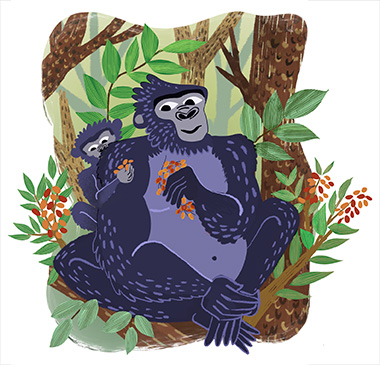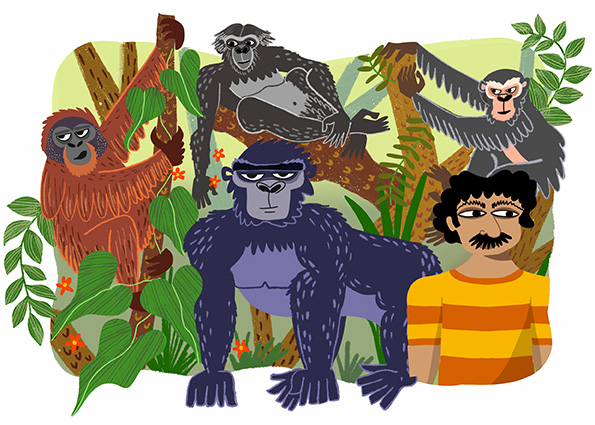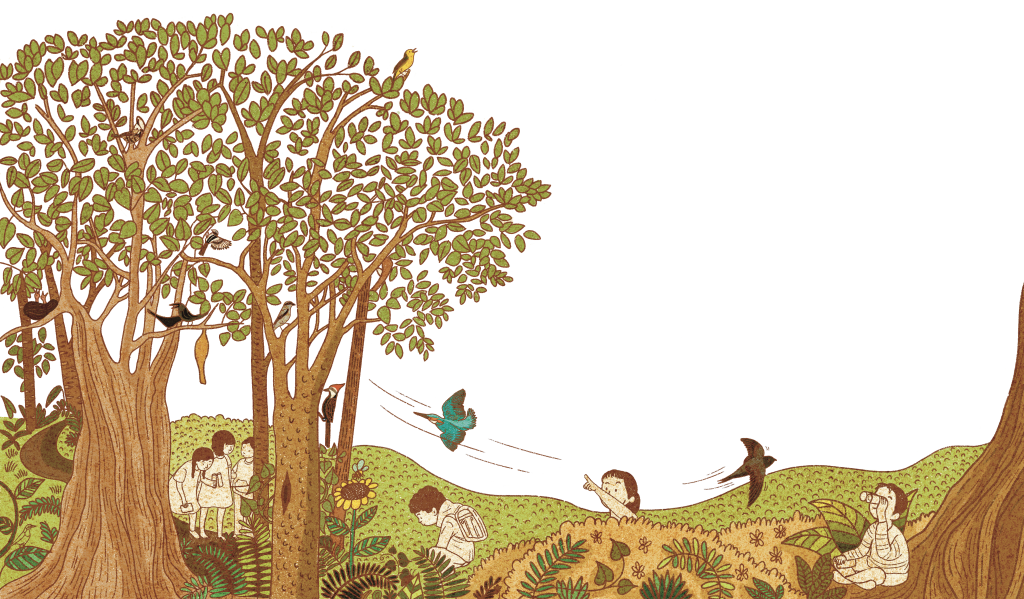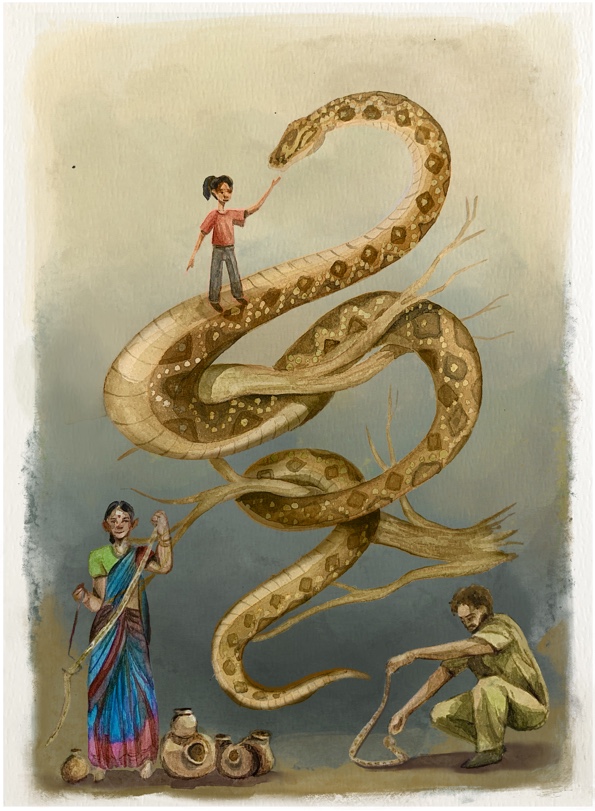Gorillas
Crash!!! The sound of breaking branches and rustling bushes can be heard throughout this national park in Uganda. The source of the noise is a 200-kg silverback gorilla and his family. They call this mountain forest their home. A gorilla troop like this one usually has around 10 members, but the largest troop ever recorded, in Virunga National Park in the Democratic Republic of the Congo, had a staggering 65 individuals. That’s a pretty big family!
An adult male mountain gorilla can grow to be over five feet tall when standing on all fours, not quite the size of King Kong but still pretty impressive. They have thick black hair covering their bodies and as they mature the hair on their backs acquires a silver sheen, earning them their names as silverbacks.
Gorillas eat leaves, shoots, roots and bark from a variety of plants. As their food is fairly low in nutrients, they need to consume up to 45 pounds or 20 kg of food, equivalent to eating 125 apples every day! Adult gorillas usually will need to rest for the better part of the day, after eating all that food, while younger gorillas spend the day playing and exploring.
Gorillas are a peaceful, social ape. But occasionally, silverbacks are known to show aggression when defending their families. At these times, silverbacks will beat their chests, bare their impressive set of canine teeth to threaten rival male gorillas or even charge at intruders when sensing danger. A fully grown gorilla can be six times as strong as a human.

Apart from the mountain gorilla (Gorilla beringei beringei), there are three other subspecies of gorilla, including the eastern (Gorilla beringei graueri) and western lowland gorillas (Gorilla gorilla gorilla) and the extremely rare cross river gorilla (Gorilla gorilla diehli). Researchers say there are fewer than 300 cross river gorillas left in the wild due to loss of habitat and hunting.
Did you know? A gorilla will sing when eating their favourite food. A combination of hums and groans to show they have found a treat too good to share.
Chimpanzees
In the same forests as the gorillas, are an even larger and noisier family of apes: the chimpanzees. This family contains many males, females and young ones of all ages.
These apes are percussive in their communication. Chimpanzees drum on tree roots to grab the attention of other chimpanzees, and perform impressive displays of their strength by ripping up plants and breaking branches to show their neighbours who’s in charge. One can often hear this display as distant drumming echoing through the forest.
Chimpanzees are loud, energetic and mischievous. The dominant male in a troop of chimpanzees forms a close bond with his brothers, uncles, cousins and sons and protects this family fiercely as this band of brothers will remain in the group for the rest of their lives. The females are much freer—they often leave their natal group after reaching sexual maturity and find a new community when they are ready to start their own families.
Chimpanzees eat fruits, nuts and seeds like the gorillas, but also seek out ants, termites, lizards and even hunt a monkey occasionally as a tasty treat. These apes are extremely intelligent and are known to use tools for a variety of reasons, such as using sticks for extractive foraging in termite mounds and rivers and using rocks for weapons during disputes with other chimpanzees.
Did you know? Chimpanzees cannot swim but love to splash around in shallow water and fish for water plants and algae to eat in the dry season.
Bonobos
Further east in the Congo River basin lives the smallest of the great apes: the bonobos. Bonobos were once known as pygmy chimpanzees because they look very similar to chimpanzees, but ancestors of this species actually split from the chimpanzee line around two million years ago. Bonobos were only discovered as a separate species in 1928 and it is thought that the natural formation of the Congo river separated them from chimpanzees. This separation was so long that they are now a distinct species.
Even though chimpanzees and bonobos look alike, their behaviour could not be more different. Unlike the chimpanzees or the gorillas, the bonobos do not show off their size and strength to intimidate others but instead use alliances and affiliations to settle disputes. Here, the females are in charge of the family, deciding where the group will sleep, travel and forage for food.
A bonobo group will often befriend neighbouring troops and individuals will move more freely between groups than the gorillas and chimpanzees. Multiple groups may also come together to form large gatherings of up to 70 animals and will talk to each other using hoots, barks, screeches and screams.
These apes have a tell-tale feature: a rather impressive hairdo. Bonobos characteristic centre parting is one of the easiest ways to distinguish them from their chimpanzee cousins.
Did you know? Chimpanzees and bonobos share over 98 percent of their DNA with humans.
Orangutans
In Asia, in the dwindling forests of Borneo and Sumatra, we find the only ape who prefers to live alone: the orangutan. Known as the red ape for their orange hair, these apes are long-armed tree dwellers who spend much of their time high up in the treetop canopy rather than on lower branches or on the forest floor like their African cousins. They spend their days feeding on fruit, seeds and leaves, and make nests out of branches to rest in throughout the day.
Even though orangutans are the least social of all the great apes, they regularly interact with each other. Young ones engage in play, adolescent males often follow other adults to learn the ways of the forest, young females may travel together or feed in the same tree as other females, and mothers will remain with their infants for up to 10 years, teaching them what they need to know to survive in the wild. Even after young females have reached maturity, they will visit their mothers often and may even share the same area of forest for many years after.
Orangutans are very clever, just like the other apes, but unlike gorillas, chimpanzees and bonobos, orangutans also have a lot of patience. They spend a long time figuring out solutions to problems and have been known to use a variety of homemade tools to collect food and water, extend their reach and make themselves more comfortable. Orangutans have been reported to have used leaves to make umbrellas to keep dry and cups which they fold and fill with water. They have been observed using sticks for fishing rods, stones for hammers and branches as weapons.
Did you know? Researchers recently discovered that orangutans use herbal remedies that they find in the forest to treat illnesses and injuries.
Humans
This brings us to our fifth and final ape: humans. These apes are far less hairy and can be found all over the world. Humans are just as diverse in shape, colour, preference and foraging and mating behaviours as seen in the other great apes. Some are short and some are tall, some are large and some are small. Some are shy and quiet, while others are loud and bold. Some have black hair and some have red hair and some may not have any hair at all! Some eat meat and some only eat vegetables. Some have large extended families and some live alone.
As a species, humans are biologically very similar to other great apes in our broader anatomy and physiology, but what makes us unique are the individual differences between us in appearance, behaviour and lifestyle, which can be largely attributed to culture.
Like other great apes, different populations of our species found in different geographical locations often have distinct cultures. The products of cultures, such as what we eat, how we communicate, our behaviours, our priorities and how we spend our time are passed down from generation to generation. All of the great apes exhibit some form of varying cultures which makes us all connected but wonderfully unique.






